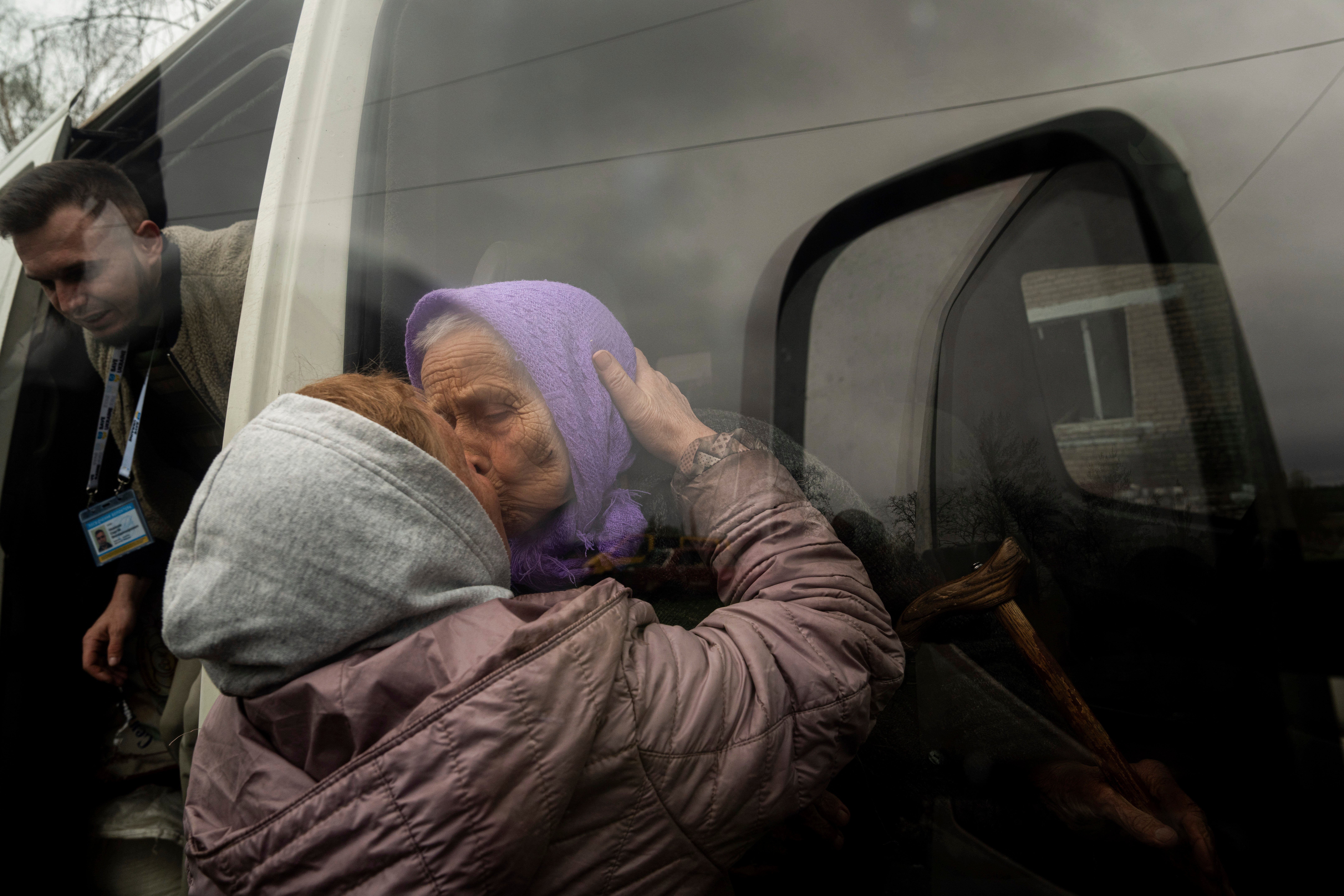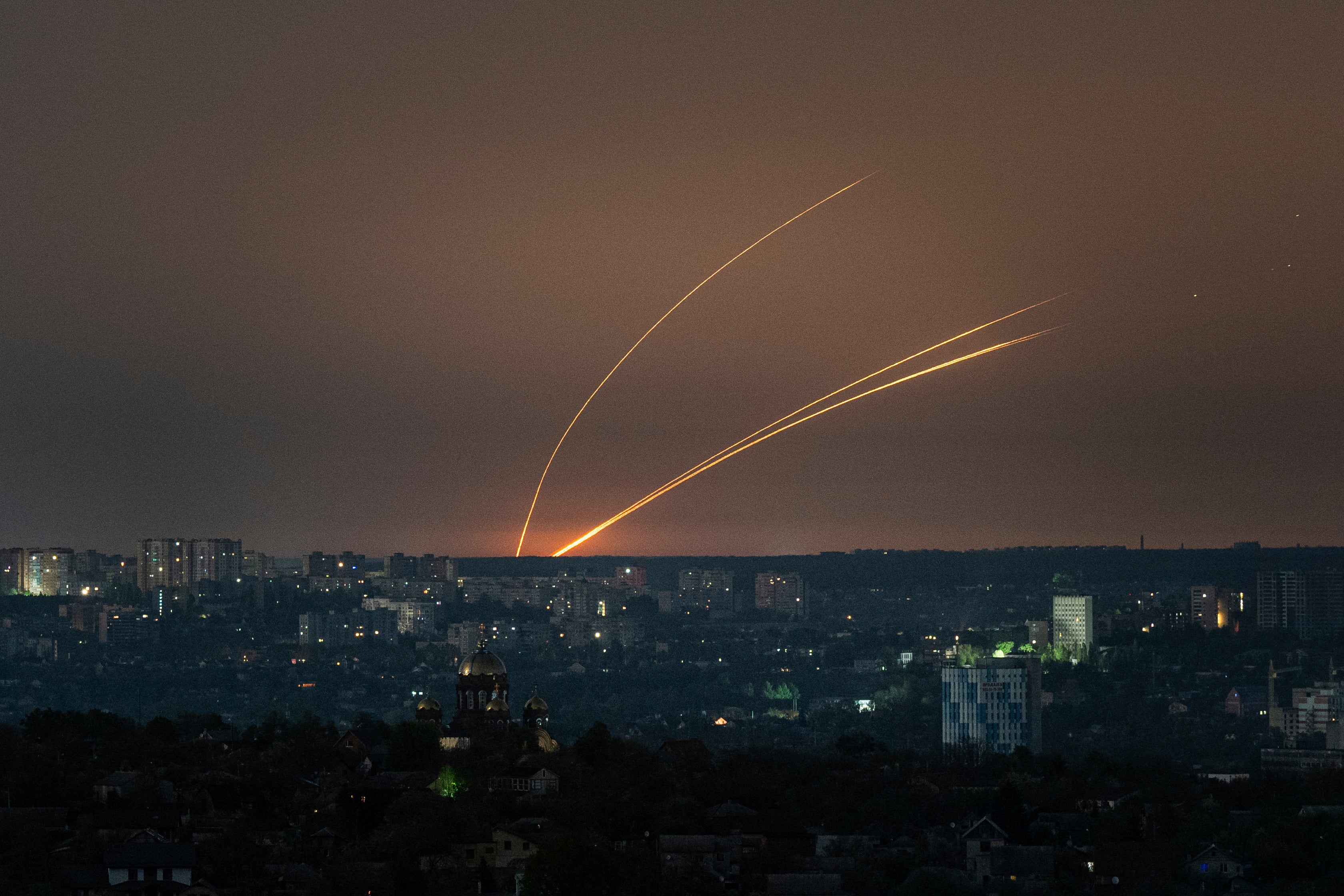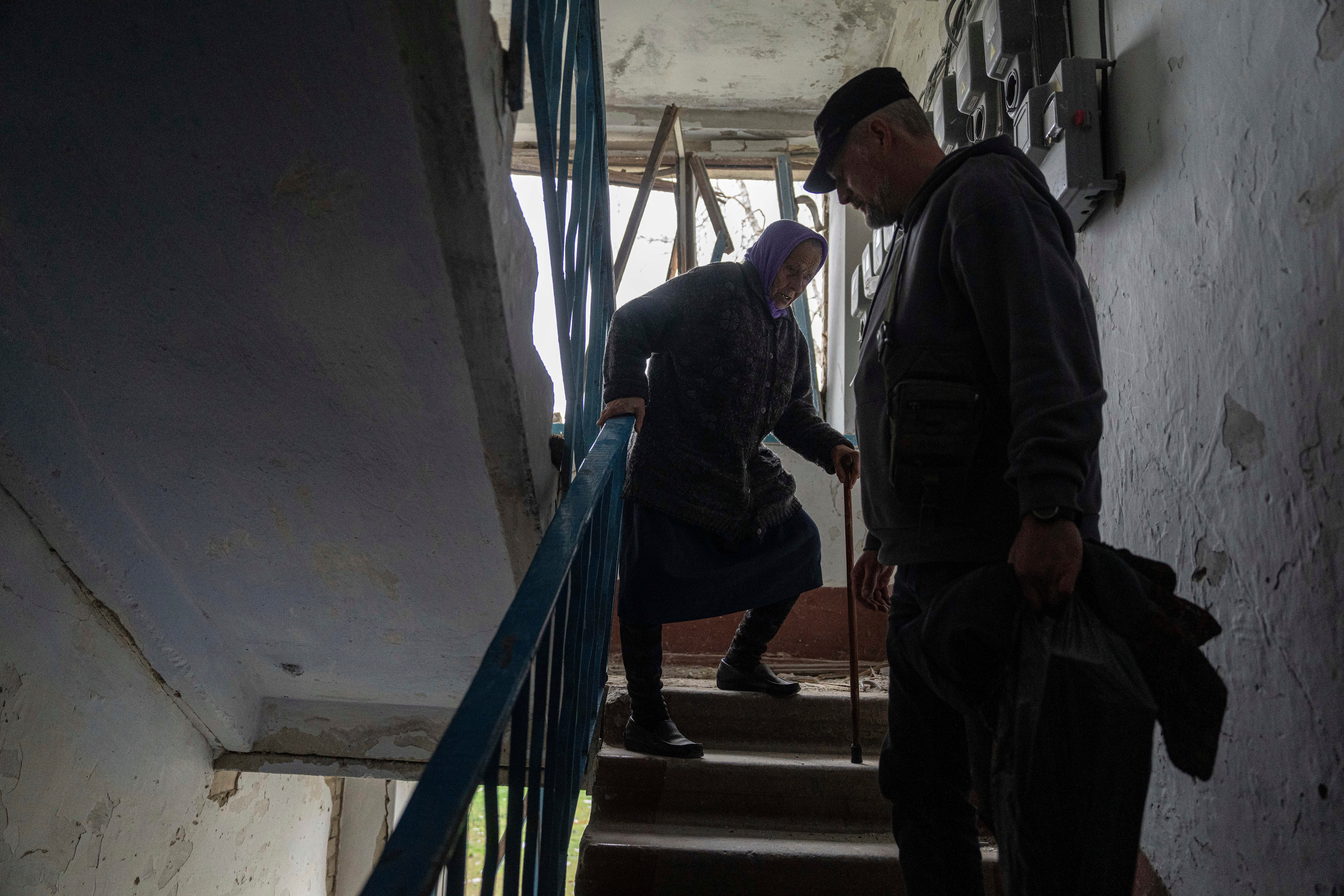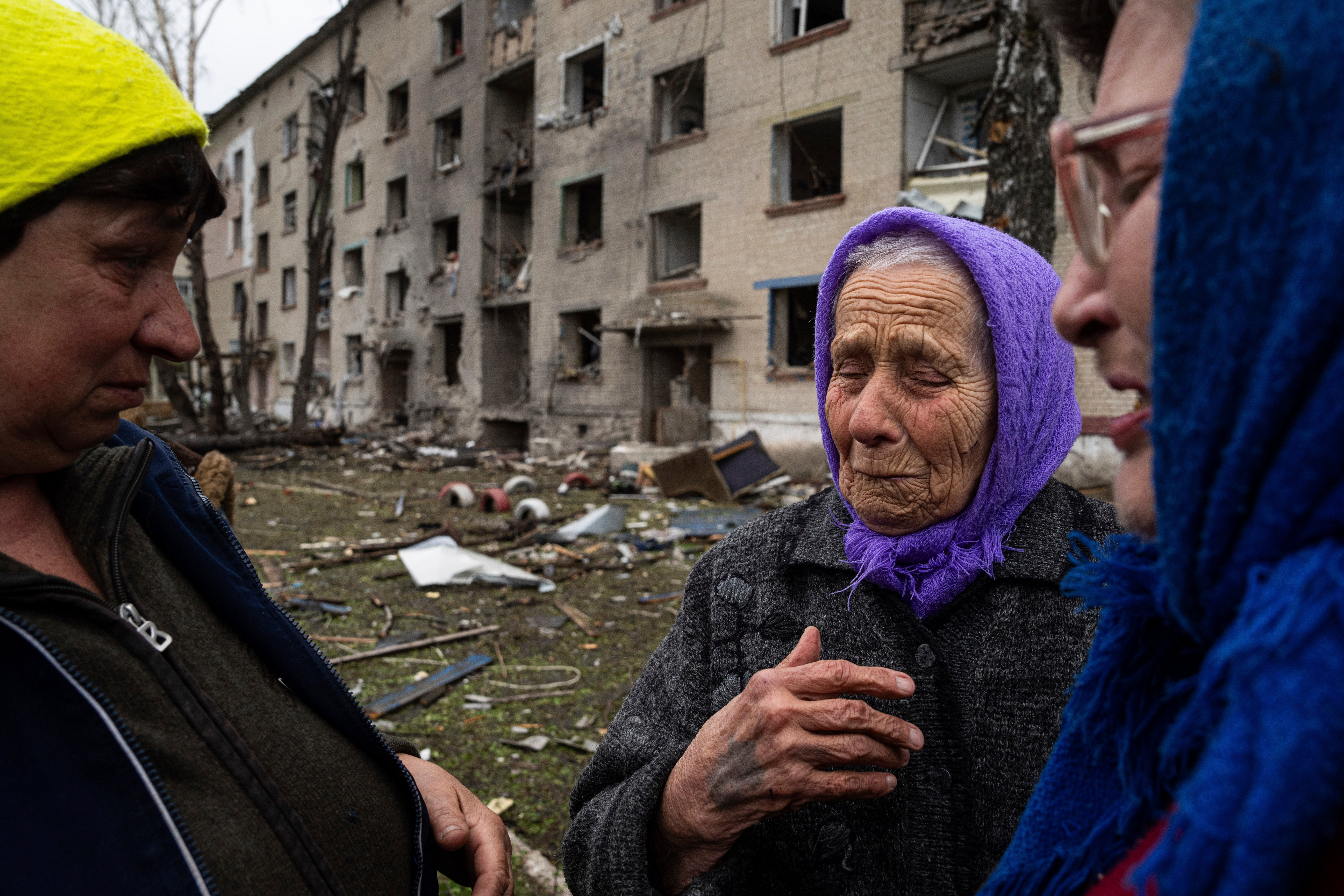As Russia closes in on Kharkiv, some residents flee. Others will never leave

A 79-year-old woman makes the sign of the cross and, gripping her cane, leaves her home in a quaint village in northeastern Ukraine.
Torn screens, shattered glass and scorched trees litter the yard of Olha Faichuk’s apartment building in Lukiantsi, north of the city of Kharkiv. Abandoned on a nearby bench is a shrapnel-pierced mobile phone. It belonged to one of two people who were killed when a Russian bomb struck, leaving a blackened crater in its wake.
“God forgive me for leaving my home, bless me on my way,” Olha says, taking one last look around before slowly shuffling to an evacuation vehicle.
In contrast to the embattled frontline villages further east, the border village near the Russian region of Belgorod was rarely attacked until a wave of airstrikes began in late March.
Russia seemingly exploited air-defence shortages in Kharkiv, Ukraine’s second-largest city, to pummel the region’s energy infrastructure and terrorise its 1.3 million residents. Nearly 200,000 city dwellers remain without power, while 50 per cent of the region’s population still suffer from outages, officials say.
As utilities clamber to meet electricity demand before the onset of winter in six months, Russia continues to unleash deadly aerial glide bombs in an effort to drive more residents away. Some officials and analysts warn that this could be a concerted effort by Moscow to shape conditions for a summer offensive to seize the city.
Acknowledging the need to strengthen the region’s air defences, Oleh Syniehubov, the governor of Kharkiv oblast, said: “We clearly understand that the enemy actually uses this vulnerability every day.”
Kharkiv’s struggles reflect a wider problem: as Western allies drag their feet in delivering promised aid to Kyiv, Moscow is patiently escalating until – it hopes – Ukrainian resistance snaps.

The attacks, which began on March 22, annihilated Kharkiv’s capacity to generate and distribute electricity.
Missiles fired from Belgorod take 30 seconds to reach their targets in Kharkiv, just 30km (18 miles) away, which is about the same amount of time needed by air-defence systems to respond. In the last barrage, Russia launched 22 missiles simultaneously to swarm and disorient those defences, Syniehubov said. Energy workers also had just 30 seconds to find cover.
At CHP-5, a plant in Kharkiv that generates electricity and heat, the acrid stench of smoke still hangs in the air. Its damaged generator and turbine must be replaced, according to plant manager Oleksandr Minkovich.
The plant supplied 50 per cent of the region’s electricity and 35 per cent of the city’s heating, Oleksandr says. It has been attacked six times since the Russian invasion began, but the latest barrage destroyed “any possibility” of power generation, he says.
A map of Kharkiv:
Spare parts for the Soviet-era plant can only be sourced from Russia, and full restoration would likely take years, he says. But Oleksandr hopes Ukraine’s Western partners will provide modern technology to decentralise power in time for winter. Without this, he says, he’s unsure how to meet demand.
To keep the lights on, power is diverted to Kharkiv from neighbouring regions, but this process overloads the grid and causes unscheduled blackouts. Businesses rarely know when, and for how long, they can rely on the grid.
“We wake up every day and have no idea if we will have power or not,” says Oleh Khromov, the owner of a popular Kharkiv restaurant, Protagonist.

Of dozens of former residents, only 10 remain in Olha’s apartment block in Lukiantsi. “Why are they killing us?” says Valentyna Semenchenko, 71, weeping as her friend is driven away.
Serhii Novikov, a volunteer with the NGO I Am Saved, which organises evacuations, says the uptick in Russia’s use of aerial glide bombs is making more communities near the Belgorod border uninhabitable.
If a bomb even falls close to a house, then it is “not suitable for habitation, because the shock wave is so large that it destroys everything in its path”, he says.
Yulia Shdanevych made the painful decision to leave her home in the nearby village of Liptsi after two adults and a child were killed in an airstrike on 10 April. Earlier missile and mortar attacks hadn’t caused any deaths, but that changed with the introduction of aerial bombs.
“Before, they would target one manufacturing building,” Yulia says. “Now it’s as though they are attacking civilians directly.”
There was no power at the shelter in Kharkiv when Yulia arrived, and she filled out paperwork by the light of a battery-powered lamp. Director Ihor Kasinksy says the facility suffers from power and water outages.
Before the war, 2,000 people lived in the village of Rubizhne, 14km from the Russian border. Today, only 60 remain, including Olha Bezborodova. But she is uncertain how long she will stay.
“It’s really hard. If we had light it would be easier,” she says, cradling her toddler. She says organisations have helped her to fix her home, “but [the Russians] are not finished, they are bombing all the time”.

Ukrainian officials are divided on the significance of the recent attacks on Kharkiv.
The president, Volodymyr Zelensky, has said it is no secret that Russia wants to take the region, but Ukraine’s military intelligence says that rumours of an impending offensive are a “psychological operation” to stir panic. Analysts argue that a larger offensive can’t be ruled out, pointing to the intensity of recent assaults.
Ukraine is not taking any chances, and has established fortifications on the outskirts of the city.
Oleksander, an engineer with one company involved in that work, says crews have been digging anti-tank ditches, laying dragon’s teeth and building a network of trenches to keep Russian forces at bay. He is not permitted to share his last name, or that of his company, for security reasons.
He has a deadline of early May to complete the job. “We will be on time,” he says.
Meanwhile, cafes and restaurants remain busy in Kharkiv, where locals have grown accustomed to speaking over the roar of generators. In Protagonist, an alternative menu presents options to order when the power is off.
“The people who are staying here and keeping businesses open and trying to do something, they are not tragic characters with nowhere to go,” says its owner Oleh. “They are a special kind of perverted enthusiast who are trying to make sense of it, who are still interested in building something.”
At a bakery nearby, workers manually record sales so that they can ration power to keep food cool.
“We try to cope,” says Oleksandra Silkina, 34. “We have been attacked since 2022, all the time, so we are used to these attacks,” she adds. “We won’t leave this city. It’s our city.”
Bookmark popover
Removed from bookmarks